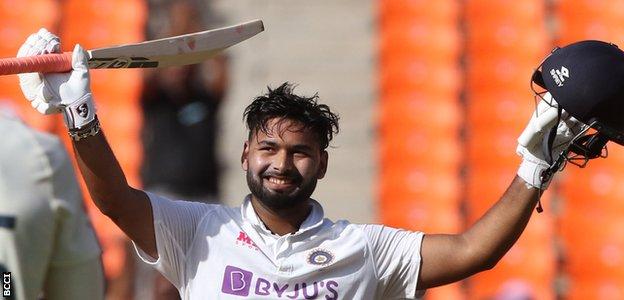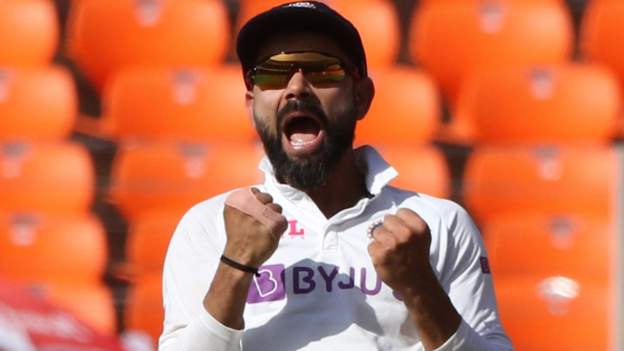Virat Kohli’s 10th successive Test series win at home erased any lingering doubts over his role as India captain.
In Australia, his deputy Ajinkya Rahane had drawn a Test and won two after Kohli returned home for the birth of his child, leading to some speculation.
When India lost the first Test to England, the whispers gained in volume.
But this is Kohli’s team, make no mistake, playing with the kind of passion and self-belief the captain himself has oodles of.
Someone once confessed, only partly in joke, that when he felt low he only had to touch Kohli for a transfer of energy. Kohli is now the third most successful captain in Test history behind Australians Steve Waugh and Ricky Ponting.
After that loss in Chennai, India got better and better, while England travelled in the opposite direction, their margins of defeat getting bigger. One team’s peaks coincided spectacularly with the other’s troughs.
The difference between a 3-1 series defeat and a 2-2 draw can hinge on team selection, poor judgement of length while batting, a rush of blood, bad luck, a disappointing umpire’s call. Or the opposition may be manifestly superior.
When England’s last wicket fell to give off-spinner Ravichandran Ashwin his 32nd wicket of the series, England could point to all of the above.
It is convenient to point to the turning pitches but twice India’s number eight batsmen showed how it could be done.
Ashwin made a century in Chennai and Washington Sundar 96 not out in Ahmedabad.
“We were outskilled,” said England skipper Joe Root with admirable honesty.


One of the first things India head coach Ravi Shastri said after the series was “we want to get out of the bubble”.
The frustration was obvious. Many India players had been in a bubble since the IPL in September
England had inaugurated ‘bubble’ Tests in July. A rotation policy was essential. Perhaps too, cricket in a bubble calls for a different set of statistical measures.
When India were 146-6 in the final Test, England might have entertained visions of a drawn series. Then Rishabh Pant played the innings of the series, including the shot of the decade while reverse-sweeping James Anderson, new ball and all.
When Washington anchored century partnerships for the seventh and eighth wickets, the difference between the teams was on public display.


India’s youngsters, first spotted by Rahul Dravid at the National Cricket Academy, and polished through under-19 and ‘A’ tours, were ready for Test cricket.
Opener Shubman Gill is 21; he made 91 in India’s successful run-chase in Brisbane in his debut series. Pant is 23, Washington 21.
Waiting in the wings, having already made a century on debut, is Prithvi Shaw, still only 21. Awaiting their turn are fast bowler Kartik Tyagi, 20, and batsman Yashasvi Jaiswal, 19.
India played a lot of their cricket against Australia and England without frontliners Jasprit Bumrah, Ishant Sharma, Mohammad Shami, Ashwin and Ravindra Jadeja, while players with fine records like KL Rahul and Hardik Pandya didn’t get a look-in. The bench strength has never been so strong.
When Mohammed Siraj and left-arm spinner Axar Patel made their debuts, they had an immediate impact.
Axar’s 27 wickets at under 11 came in just three Tests. In batsmen’s nightmares, the figures of Ashwin and Axar will loom large.
It meant that despite the relative failures of the seniors Kohli (172 runs in the series, fewer than Ashwin’s tally), Cheteshwar Pujara (133) and Ajinkya Rahane (112), the team played with the confidence that somebody would deliver.
This was in contrast to England for whom the seniors Root, Ben Stokes, Anderson had to deliver day in and day out.
They had their moments – Root scoring a double century in England’s win and later claiming 5-8 with his occasional off-breaks to highlight the folly of selecting a team packed with medium pacers.
Anderson sent down possibly the most stunning over of swing bowling ever seen in India in the opener, getting Gill and Rahane in the same over, the ball naughtily travelling through bat and pad like a child entering a circus through a gap in the tent.
It led to England’s sixth win in a row in the sub-continent, and momentarily dented India’s chances of qualifying for the World Test Championship (WTC) final.


Interestingly, Kohli had called the change of rules for the WTC (brought on by the Covid-19 pandemic) “confusing” before the Australia tour.
Then he called it a “distraction”, which Shastri echoed. Now that India are in the final, “we can’t wait,” Kohli says.
It is an interesting sequence, and reflects how India reacted to two other World Cups – the 50 over and the T20.
Through much of the 1970s, India looked down at the shorter format, considering it a mere distraction from the “real” cricket, which was Test cricket. Then they won in 1983 and the world changed.
History repeated itself with T20 which India were disdainful of and saw as a joke. After they won that World Cup in 2007, things were never the same again. For one, it led to the IPL, and altered the face of cricket.
In June, when they take on New Zealand in the WTC final in England, India will approach it with a seriousness missing in ’83 or ’07. They would have liked a three-match final, and if they win might convince the International Cricket Council to take a fresh look at the format.

Although neither Kohli nor Shastri has used the expression, the five-Test series in England in August might be seen as India’s ‘final frontier’.
India last won there in 2007 and since then have fared miserably on three tours.
The ‘New India’ – a term Kohli is fond of using – has won the last two series in Australia and will look to change their lopsided record in England.
The teams might be out of the bio-secure bubble by then, bringing a touch of normality to the show.

